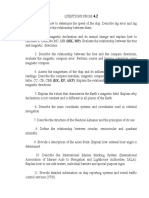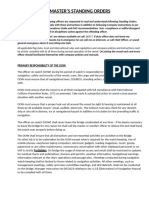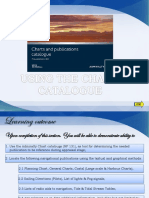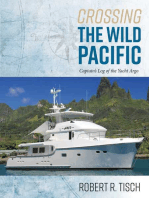100%(1)100% found this document useful (1 vote)
76 viewsSqa Nav Notes 2
Sqa Nav Notes 2
Uploaded by
Sabeena PoonwassieThe document lists equipment that should be checked prior to a vessel's arrival in port, including clocks, propeller controls, deck power, navigation aids, sounders, position fixing systems, engine stops, engines, compasses, communications, lights, signals, steering gear, and thrusters. It also outlines four checks for navigating in ice, including moderate speed, frequent sounding of tanks and bilges, monitoring ice advisories, and transmitting danger messages. Finally, it provides requirements for ice and severe ice accretion reports, including type, position, time, temperatures, and wind details.
Copyright:
© All Rights Reserved
Available Formats
Download as DOCX, PDF, TXT or read online from Scribd
Sqa Nav Notes 2
Sqa Nav Notes 2
Uploaded by
Sabeena Poonwassie100%(1)100% found this document useful (1 vote)
76 views2 pagesThe document lists equipment that should be checked prior to a vessel's arrival in port, including clocks, propeller controls, deck power, navigation aids, sounders, position fixing systems, engine stops, engines, compasses, communications, lights, signals, steering gear, and thrusters. It also outlines four checks for navigating in ice, including moderate speed, frequent sounding of tanks and bilges, monitoring ice advisories, and transmitting danger messages. Finally, it provides requirements for ice and severe ice accretion reports, including type, position, time, temperatures, and wind details.
Original Description:
SQA NAV NOTES 2
Original Title
SQA NAV NOTES 2
Copyright
© © All Rights Reserved
Available Formats
DOCX, PDF, TXT or read online from Scribd
Share this document
Did you find this document useful?
Is this content inappropriate?
The document lists equipment that should be checked prior to a vessel's arrival in port, including clocks, propeller controls, deck power, navigation aids, sounders, position fixing systems, engine stops, engines, compasses, communications, lights, signals, steering gear, and thrusters. It also outlines four checks for navigating in ice, including moderate speed, frequent sounding of tanks and bilges, monitoring ice advisories, and transmitting danger messages. Finally, it provides requirements for ice and severe ice accretion reports, including type, position, time, temperatures, and wind details.
Copyright:
© All Rights Reserved
Available Formats
Download as DOCX, PDF, TXT or read online from Scribd
Download as docx, pdf, or txt
100%(1)100% found this document useful (1 vote)
76 views2 pagesSqa Nav Notes 2
Sqa Nav Notes 2
Uploaded by
Sabeena PoonwassieThe document lists equipment that should be checked prior to a vessel's arrival in port, including clocks, propeller controls, deck power, navigation aids, sounders, position fixing systems, engine stops, engines, compasses, communications, lights, signals, steering gear, and thrusters. It also outlines four checks for navigating in ice, including moderate speed, frequent sounding of tanks and bilges, monitoring ice advisories, and transmitting danger messages. Finally, it provides requirements for ice and severe ice accretion reports, including type, position, time, temperatures, and wind details.
Copyright:
© All Rights Reserved
Available Formats
Download as DOCX, PDF, TXT or read online from Scribd
Download as docx, pdf, or txt
You are on page 1of 2
BPG-Eight items of equipment that should have been prepared and checked prior to
vessel’s arrival in port.
B7-Preparations for Arrival
Equipment Checks (Tested and Ready for Use)
1. Clocks synchronized with engine room
2. Controllable pitch propeller controls and indicators
3. Deck power
4. ECDIS and/or other electronic navigation aids
5. Echo sounder
6. Electronic position fixing systems
7. Emergency engine stops
8. Engine(s)/propulsion (ahead and astern)
9. Gyro/magnetic compass and repeaters, including repeater in steering gear area
10. Internal communications (particularly bridge to engine room/bridge to mooring stations)
11. Navigation lights, shapes and sound signals
12. RPM and ROT indicators
13. Signaling equipment including flags, search lights and signal lamps
14. Steering gear (Checklist B1) Thrusters
Four (4) checks by the OOW Navigating in Ice (BPG B15-Navigation in Ice *) - MIMTIC
1. Moderate speed as appropriate in the conditions
2. Increase the frequency of sounding tanks and bilges
3. Monitor ice advisory service broadcasts
4. Transmit danger messages in accordance with SOLAS
*Action
Inform the Master of the proximity of ice
Inform the engine room of the proximity of ice
Inform the crew of the proximity to ice
Close all watertight doors
Outline the reporting requirements of ;
Ice -The message should contain
1. The type of ice
2. The position of the ice
3. GMT and date of the observation
Severe ice accretion-The message should contain:
1. The date and GMT
2. The position of the ship
3. The air and sea temperatures
4. The force & direction of the wind
You might also like
- 2M Cargo Notes by AnupamDocument87 pages2M Cargo Notes by AnupamAmaan MoyalNo ratings yet
- Oow Reading ListDocument1 pageOow Reading ListNikNik001No ratings yet
- SQA Written Exam Notes PDFDocument115 pagesSQA Written Exam Notes PDFSyamesh SeaNo ratings yet
- Magnetic Compass - Oral COCDocument10 pagesMagnetic Compass - Oral COCNaeem100% (1)
- Sqa Oow Navigation Answers For Theory PartDocument74 pagesSqa Oow Navigation Answers For Theory PartNelum Perera100% (1)
- Master Oral Question Bank-1Document2 pagesMaster Oral Question Bank-1cheriannair100% (1)
- Ship HandlngDocument3 pagesShip Handlngcaptyashpal100% (4)
- Sqa Nav Notes Part 1Document4 pagesSqa Nav Notes Part 1Sabeena PoonwassieNo ratings yet
- Anchorages and Marinas of the Eastern Canaries: Sailing off the Coasts of Lanzarote, Fuerteventura and Gran CanariaFrom EverandAnchorages and Marinas of the Eastern Canaries: Sailing off the Coasts of Lanzarote, Fuerteventura and Gran CanariaNo ratings yet
- 23 SQA NAV Gangaram Theory-1Document23 pages23 SQA NAV Gangaram Theory-1kumar100% (1)
- Sqa Nav Theory 2015 To 2019 UpdatedDocument196 pagesSqa Nav Theory 2015 To 2019 Updatedvijay bhatiaNo ratings yet
- Answers (1) Cargo WorkDocument19 pagesAnswers (1) Cargo WorkAjayRaghupathiNo ratings yet
- 2nd Mates SyllabusDocument11 pages2nd Mates SyllabusSarang TurekarNo ratings yet
- 5 Questions PapersDocument8 pages5 Questions PapersSureen NarangNo ratings yet
- OOW Navigation 2005 2015 AnswersDocument11 pagesOOW Navigation 2005 2015 AnswersSoul MarinerNo ratings yet
- Stability SqaDocument20 pagesStability SqaSujeet sharma100% (1)
- 2015 Jul OOW Stability SQA Past PaperDocument5 pages2015 Jul OOW Stability SQA Past PaperAjit TiwariNo ratings yet
- Ror (20791)Document60 pagesRor (20791)Aamir Sirohi100% (2)
- NAVIGATION SolutionDocument40 pagesNAVIGATION SolutionMd Monir Hossain100% (3)
- Celestial Navigation Notes 2019 v1.1Document15 pagesCelestial Navigation Notes 2019 v1.1Ashish100% (1)
- Stability Talkie TalkieDocument46 pagesStability Talkie TalkieSakthi Javelin100% (1)
- English Channel Chartwork ProblemsDocument9 pagesEnglish Channel Chartwork ProblemswaseemNo ratings yet
- Buoyage SystemDocument5 pagesBuoyage SystemSandipanBiswas100% (1)
- SQA Navigation Formulae Sheet MIN198Document1 pageSQA Navigation Formulae Sheet MIN198Alberto NeriNo ratings yet
- Orals MCQDocument9 pagesOrals MCQaungthein_sanNo ratings yet
- MGN 315 NotesDocument6 pagesMGN 315 NotesMandy Conquers100% (5)
- Orals Report 09/04/14: Candidate: Mark Johnson Time: 1030 Examiner: Capt. Insan!! Result: PASSDocument4 pagesOrals Report 09/04/14: Candidate: Mark Johnson Time: 1030 Examiner: Capt. Insan!! Result: PASSsergiyNo ratings yet
- Gyro 1 PDFDocument11 pagesGyro 1 PDFAakarSingh100% (1)
- 13a. Rendezvous MasterDocument17 pages13a. Rendezvous MastertonyNo ratings yet
- Tidal Prediction Form2Document1 pageTidal Prediction Form2Sunny Bebs R. BasasNo ratings yet
- 2nd Mate Func1 QuestionsDocument3 pages2nd Mate Func1 Questionsinkugeorge100% (1)
- VERY IMP 2nd Mate Fun 1Document90 pagesVERY IMP 2nd Mate Fun 1Jayesh Solaskar100% (2)
- QUESTIONS FROM 4.1 and 4.2 A.D. REVISED A.D.Document5 pagesQUESTIONS FROM 4.1 and 4.2 A.D. REVISED A.D.Oleksandr Plaksin100% (1)
- Masters Standing Orders FINAL 21.07.23Document11 pagesMasters Standing Orders FINAL 21.07.23ujjwalmuskanNo ratings yet
- Aarthik Kanal Masters Oral Report Capt JacksonDocument2 pagesAarthik Kanal Masters Oral Report Capt Jacksonsergiy100% (1)
- Kolkata MMD Oral Questions 2012 Function 1Document12 pagesKolkata MMD Oral Questions 2012 Function 1Ujjwal VermaNo ratings yet
- Chief Mate Stability Answers 2005 2015Document5 pagesChief Mate Stability Answers 2005 2015paresh devalia100% (1)
- Ecdis "Dual Fuelling"Document11 pagesEcdis "Dual Fuelling"aungthein_sanNo ratings yet
- Is Weather The Same As Climate?: A Question We Ask Very Frequently ButDocument63 pagesIs Weather The Same As Climate?: A Question We Ask Very Frequently ButPragya NamaNo ratings yet
- Deck Ref LibraryDocument25 pagesDeck Ref LibrarycptmehmetkaptanNo ratings yet
- Maritime Books by Indian Authors-Part IDocument2 pagesMaritime Books by Indian Authors-Part Ipothirajkalyan50% (2)
- Astronomical Position LinesDocument24 pagesAstronomical Position LinesRamachandranNo ratings yet
- Notes On CompassDocument19 pagesNotes On CompassThapliyal Sanjay100% (1)
- Using The Chart CatalogueDocument8 pagesUsing The Chart CatalogueCLIJOHN PABLO FORD100% (1)
- Phase I - Meteorology - MMD Question Paper 2022 2012Document42 pagesPhase I - Meteorology - MMD Question Paper 2022 2012Arpit MeenaNo ratings yet
- Chart WorkDocument12 pagesChart WorkNaveen Prathapachandran100% (1)
- Weather Copy 2Document13 pagesWeather Copy 2api-240158555100% (1)
- Firstmate OralsDocument9 pagesFirstmate OralsprabhupillaiNo ratings yet
- Special Areas Under MARPOL PDFDocument2 pagesSpecial Areas Under MARPOL PDFNuri Kayacan100% (3)
- SQA Stability PapersDocument2 pagesSQA Stability PapersBo Salter80% (5)
- Admiralty e NP FactsheetDocument4 pagesAdmiralty e NP FactsheetVisveswaran Inbasekaran100% (1)
- DF0LV34 - Chartwork and TidesDocument11 pagesDF0LV34 - Chartwork and TidesEdvin Edw100% (2)
- Chief Mate Unlimited Navigation SyllabusDocument9 pagesChief Mate Unlimited Navigation Syllabusfriends_is100% (1)
- SQA Ans by GangaDocument26 pagesSQA Ans by GangaGangaram Bomidi75% (4)
- Navigation Talkie 2Document13 pagesNavigation Talkie 2Ajit Kumar MohapatraaNo ratings yet
- Stability MCA OOW June 2005Document6 pagesStability MCA OOW June 2005Tom Alex100% (1)
- Nautical PublicationsDocument15 pagesNautical PublicationsNeeraj SNo ratings yet
- Understanding a Nautical Chart: A Practical Guide to Safe NavigationFrom EverandUnderstanding a Nautical Chart: A Practical Guide to Safe NavigationRating: 3 out of 5 stars3/5 (1)



























































